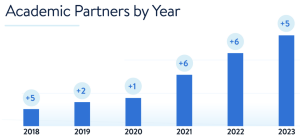In recent months, many CHROs may well have read about more and more employers that are now offering to help pay for their employee’s continued education.
Examples include the likes of Amazon (with its Career Choice program that helps pay the costs of several different educational experiences, including a bachelor’s or associate’s degree); Boeing (which offer tuition reimbursement for undergraduate and graduate degrees); Disney (workers can use the Disney Aspire program to cover GED, college prep, ESL, trade programs) and Home Depot – which promises to reimburse up to 50% of tuition up to a maximum of $3,000 for full-time hourly employees and up to $1,500 for part-time employees.
The Starbucks College Achievement Plan takes things even further, by helping employees cover college costs with 100% upfront tuition and fee coverage through Arizona State University’s online program, while staff at Taco Bell might be eligible for 100% paid tuition for select degrees, high school diplomas, professional certificates.
Do they work though?
For decades, companies have gone down this route in the hope that it will boost retention, while at the same time have motivating effect on staff, and bring about the development of their employees’ skills.
That, however, is the theory. Because according to new research from Harvard Business Review Analytic Services (HBR-AS), commissioned by Strategic Education, Inc., the evidence is rather more to the contrary.
As well as showing that there is often lack of awareness of such schemes in the first place (and that the options they have are limited), there are also issues around managers supporting people doing tuition, and most notably, companies not having metrics on hand about how well the schemes are performing from an ROI perspective (see below).

To learn more about this, TLNT spoke to Joe Schaefer, president at Strategic Education Inc to learn about how TA programs can be run more successfully:
Q: What else did you research show?
A: “Although 89% of business leadership surveyed agreed that there is a strategic value in offering employee education benefits, 39% said their organization has not evaluated or made updates to its tuition assistance program within the past three years. This lack of attention to TA benefits may mean that employers are not getting a full return on their investment.”
Q: What common pitfalls do you see?
A: “In managing more than 50 corporate TA benefit programs, I have seen many of the common pitfalls. I have also seen how even modest updates can greatly increase employee uptake and the ROI to the organization. To sum it up: successful programs put the needs of employees at the center.
Here are the main factors that I believe can make or break a TA program:
Build and communicate different pathways
A TA benefit program may have more success if the employer offers various degree and non-degree programs aligned with their business objectives and allows employees to choose their preferred pathway.
For example, an IT company may offer both degree and non-degree programs in technology, business and marketing.
When employees have more control over what they can study, they may be more likely to take advantage of the benefit that may help in retaining internal talent to fill critical roles.
Importantly, don’t forget to communicate with employees about the program as early and as often as possible.
Many of the business leadership (35%) surveyed said employees lack awareness or information about the TA program.
Flexibility and Support
Unlike other benefits, pursuing an education can require a substantial time investment on the employees’ part.
According to surveyed business leadership, the most common challenge their organizations experience with its tuition assistance program is that employees do not feel they have enough time to pursue education while working (45%).
This means addressing the financial barrier to education by paying for tuition is only one part of the equation.
It can be equally important to show them the value of their time investment and provide them with support throughout the education program.
Consider partnering with schools that offer flexible education models, in which employees can learn virtually, and at their own pace.
Offer mentoring, coaching, or personalized support to help guide an employee through their educational journey.
Measurement
Surprisingly, nearly 40% of business leadership surveyed report their organization lacks the metrics to understand how their tuition assistance program is performing.
In my experience, the programs that tend to be most successful continuously measure the program’s impact on employee retention, skills and competencies gained, participation and completion rates, as well as feedback from employees on the experience.
Some education benefit platforms offer measurement tools to track a return on investment (ROI) and help employers reinforce the value of TA programs to employees and the organization.
Q: What are your overall reflections?
A: “Overall, it is important to remember that tuition assistance benefits are not just a nice perk for employees; they can be a valuable tool for employers – but only if they’re implemented in such a way that puts employees at the center. Whether it’s through better motivation, increased retention and more up-skilling, this investment can pay off in dividends. But like any effective business investment, it should be evaluated and updated to keep pace with workforce demands.”
Joe Schaefer is President of Education Technology Services, Strategic Education Inc.
CASE STUDY: WALMART:


In 2018, retail giant Walmart launched its own education program, Live Better U (LBU).
It covers 100% of the cost of tuition and books for part-time and full-time Walmart and Sam’s Club associates. Staff can access the benefit from day one of joining the company.
From foundational offerings like high school completion to short-form programs, including business analytics and project management, to college degrees, associates can access academic programs from 26 of the nation’s leading academic partners
Last year it revealed that in the first five years of it running, it had saved 104,000 participating associates nearly half a billion dollars in tuition costs.


More than 70 programs in total are now funded, including those in high-demand areas, such as supply chain.
